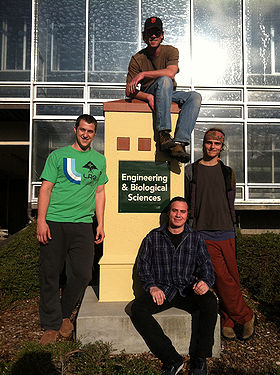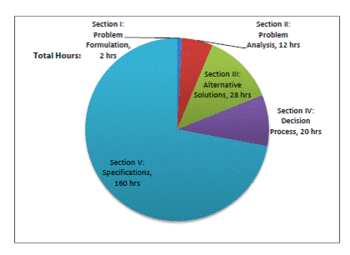
Abstract
Friends of the Dunes, the client, contacted Humboldt State University to design and construct various aspects of the Humboldt Coastal Nature Center (HCNC). Team Little Blue Dune Buggy was formed to design and implement trail lighting from the parking lot to specific events hosted at the HCNC. Many brainstorming sessions resulted in several alternative solutions for the trail lighting. Each of these solutions were compared and scored according to how well they met specified criteria. The final solution was chosen through this process and several discussions with the client. The implemented solution incorporates a solar powered light charging station.


Background
Since 1982, the not-for-profit organization Friends of the Dunes (FOD) has aided in the conservation of coastal lands. FOD hosts many community based restoration efforts as well as educational programs and guided tours. Carol Vander Meer has been the representative of FOD who meets with us on a weekly basis. Throughout the design process she has stressed the importance of the trail lighting for special events hosted at night. The lighting will be implemented from the parking lot to the Humboldt Coastal Nature Center for these evening events.
Objective Statement & Criteria
Problem Statement
The trail connecting the parking lot of Friends of the Dunes' to the Stamps house needs to be illuminated to guide visitors to special evening events.
Criteria
The specified criteria as discussed by the group with the client is listed on a scale of 1-10 below.
| Criteria | Weight | Description |
|---|---|---|
| Leveraging Local Resources | 6 | Must try to use as many local and donated resources as possible. |
| Trail Coverage | 10 | Must cover 150 feet of trail at a two foot height. |
| Cost | 8 | The final product must cost no more than $400. |
| Appropriateness of Materials | 6 | Consider environmentally friendly materials when designing the trail lighting. |
| Safety | 10 | Must follow all building codes including the international electric code. |
| Educational Values | 5 | Educational information is not required, but would add to the project. |
| Ease of Use/ Maintenance | 8 | Must be able to be used by volunteer workers.Maintenance must be able to be completed by volunteer workers. |
Final Design
The final design begins with the sun. The design implements two photovoltaic panels, rated at (6 volts and 60 watts each), which will harness energy from the sun to power the lighting for the trail. When in use, the panels will be angled so that they can best capture incoming sunlight. The panels will be held at their angle with a rod that is attached to the panel with a hinge. This rod folds out and locks the panels into place. Wiring will run from the back of the solar panels into the device and connect to a (15 amp) charge controller. The charge controller keeps the machine from over-charging itself and removes the risk of fire or explosion from over-charging. The wiring from the charge controller then leads into a (100 watt) power inverter which converts the DC electricity made by the solar panels into AC electricity that will be used to charge the lights. Two surge protectors will be plugged into the power inverter to allow for more than two lights to be charged at a time. The charging cables for the lights will be plugged into the surge protectors and run through small holes on the side of the device. The cables can then be plugged into the lights which will be hanging from hooks on the side of the device. Figure 5-3 shows the electrical components used in the design. The body of the device will be made of wood and will have four wheels, two with locks, in order that it may be moved into a proper location to receive adequate solar energy. The wheels also allow for it to be moved inside at night to protect from any forms of vandalism.
The lights being used in the design are ten 5 watt L.E.D 130 lights provided by Cooper Industries. Each light takes about 4 hours of sun to fully charge. Throughout the year the lights will take various lengths of time to charge due to various amount of solar radiation in each month. These lengths can be calculated using the table and equations provided in the how to build section. Once charged, the lights can be stored until an event that requires lighting for the trail. Due to the high lumen output of each light, not all ten will be needed to give enough light to the trail. This allows for volunteers at the event to replace any light that may go out during the event with another fully charged one. The lights will be spaced along the trail, angled towards the ground on individual bars.
Costs
Design Hours
The image on the right displays the total number of hours spent on each section of the design project.

Material Costs
Below are the costs of each component of the solar powered light charging station. Significant cost reduction occurred as a result of donations from Cooper Industries. The overall cost of the solar powered light charging station was (TOTAL COST).
| Material | Qty | Our Cost ($) | Retail ($) |
|---|---|---|---|
| Lights | 10 | 0 | 400.00 |
| PV Panel | 1 | 0 | 239.99 |
| Wiring | ? | ? | ? |
| Wheels (Locking) | 2 | ? | ? |
| Wheels (Non-locking) | 2 | ? | ? |
| Surge Protector | 2 | 10.00 | 10.00 |
| Outlet Box | 1 | 1.00 | 1.00 |
| Charge Controller | 1 | 40.00 | 40.00 |
| Wood | ? | ? | ? |
| Caulking | ? | ? | ? |
| Screws | ? | ? | ? |
| Material Description | Quantity | Our Price | Retail |
| Material Description | Quantity | Our Price | Retail |